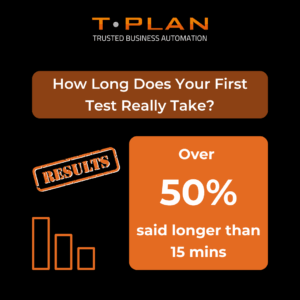Automation testing is crucial for ensuring consistency, quality, efficiency and user satisfaction in your mobile apps and games. The purpose of automating your app testing extends beyond just identifying pre-release bugs – it allows you as a developer to maintain consistent performance across real devices, quickly adapt to iOS updates, and ensure platform testing for all devices, minimizing disruption.
Automating iOS app testing also helps simulate diverse user interaction to verify that all in-game actions and UI elements function as you intend them to. Another thing to consider are Apple’s stringent App Store requirements mean that a poorly functioning app, lacking thorough accessibility testing or UI tests, is unlikely to succeed. By automating app testing with a best-in-class automation tool like T-Plan, you ensure every app or game version delivers a consistent and bug-free experience to your users.
But where do you start with iOS automation testing, and what’s important for software developers to consider in order to leverage it effectively for app and game development?

Table of Contents
The basics of iOS automation testing
iOS automation testing uses specialised tools and automation frameworks to conduct tests automatically. This testing can include unit and integration tests as well as interface and performance tests, and it ensures that every aspect of the game operates as expected on various iOS devices. Not only does it test functionality but also assesses user experience elements such as graphic performance and touch responsiveness.
For example – you may want to test that buttons appear correctly across different language variants. Languages such as German can include exceptionally long words, and if this hasn’t been considered in development you could end up with key user journey touchpoints that either don’t function as intended or look incorrect.
Automated tests can highlight issues like this that might not have been picked up in your normal manual testing process and allow you to fix them prior to release – which is an infinitely better situation than having an annoyed user bring the issue to your attention by leaving a bad review and you having to deploy a hotfix.
The test code lifecycle for iOS automation encompasses several key stages:
- What are your goals? What are you actually testing? Which tools are you going to use? What is the test criteria?
- Which test cases and scripts are you going to use? Which specific functionalities are you going to test? Do you want to check visual elements or are there specific user journey touchpoints that need to be stress tested for correct functionality?
- This is where you actually run the tests, and you find out exactly what the test has identified so you can plan to rectify it prior to launch – be they bugs, performance issues or design problems.
- Maintenance: At the game evolves, test scripts need updates and modifications to align with new features or changes. Continuous updates in test scripts are critical to keeping automation relevant and effective.
We don’t need to tell you that without consistent and continuous testing, bugs WILL make it to production. Integrating testing into every stage of the development process helps catch issues early in the development cycle. Additionally, the cost to fix these issues is a lot less prior to launch than after it – and hotfixes often need to be deployed with significant urgency if something critical does not work as expected. Automation of those continuous tests helps to support rapid iteration and frequent updates, as well as helping to reduce human error ensuring that new features continue to be functional and harmonious with all existing elements.
So now we’ve convinced you that automation testing is really something you should be doing, let’s take a look at the tools and technologies you can use to perform effective automation tests on iOS apps.
Tools and technologies
There are several different tools out there to help you automate iOS app or game testing. Some of these tools you pay for – some you don’t. Some of these tools are tools that you’re expected to use yourself with very little outside assistance, and some (like T-Plan) come with extensive third-party technical support to help you get the most out of them.
Here are some of the most prominent tools available on the market that you might come across – this isn’t, however, an exhaustive list and many more tools exist.
Native tools (XCTest, XCUITest)
Apple’s native framework, XCTest and XCUITest, are deeply integrated within Xcode which provides a seamless environment for developing and testing iOS applications. XCTest is used for unit testing which allows developers to check smaller blocks of code for functionality. XCUITest on the other hand, is tailored for UI testing enabling testers to interact with the applications user interface and simulate user actions, ensuring the UI behaves as expected.
Why you might want to explore native tools like XCTest and XCUITest
They integrate seamlessly. Both XCTest and XCUITest are integrated directly into the Xcode IDE (Apple’s integrated development environment), making setup and execution of tests straightforward, without the need for additional tools or configurations.
They’re specifically optimised for iOS. As these are Apple’s proprietary tools, they are well optimised for iOS and provide robust support for all iOS features and updates.
They perform well and they’re reliable. These tools offer high performance and reliability in executing tests, ensuring that they run smoothly and efficiently on all compatible devices. You’re unlikely to be chasing your tail trying to find out the cause of a weird error or some other minor compatibility issue causing your test to break.
Cross-platform tools (such as Appium or Selenium)
Appium is a popular open-source tool for test automation on mobile applications, used for both iOS and Android platforms. It allows the use of the same API to run tests across multiple platforms, which is particularly useful for game and apps developed under a cross-platform development strategy. There are many third party tools which are basically Appium packaged up into a nicer GUI, but fundamentally perform the same functionality as Appium itself.
Why you might want to explore cross-platform, open source tools like Appium
They tend to be very flexible when it comes to development languages. Appium in particular supports multiple programming languages, including Java, Ruby, Python and C#.
There’s (sometimes) good community support. Being open-source, a lot of these tools have a strong community support network that contributes to continuous improvements.
However, while it’s often possible to find gold nuggets inside some of these support forums, it’s absolutely inevitable that you’re eventually going to stumble across a forum post where someone asks a similar question to yours and either doesn’t get a response, or comes back with “never mind, I fixed it” without actually telling you what they did to fix it.
Additionally you may find that you’re looking at Github projects that are a couple of years old and have since been archived, meaning you’re out of luck for any kind of help or support.
They (generally) don’t require any modification to the app’s code. Tools like Appium don’t not require any modification to the app’s code base to automate testing. This makes open source tools less intrusive and easier to implement than other tools.
Specialised tools (T-Plan)
T-Plan Robot is a multi-platform tool that works on iOS as well as Android – which many other paid tools can’t do. It’s very rare that a developer releases an app on either only the Play Store or the App Store, so T-Plan will help you maintain a consistent user experience across iOS and Android in a way that many other tools can’t.
We offer a robust solution which is tailored to meet specific testing challenges, such a synchronisation issues in multiplayer games or performance under various network conditions.
(It’s also worth mentioning that other specialised tools that you need to pay for do exist in the marketplace.)
Why you should explore a specialised tool like the T-Plan robot
We offer custom solutions. T-Plan provides tools that can be customised to address specific testing needs, offering a high degree of control over test scenarios and condition.
Our tool is capable of advanced synchronisation. For games involving complex user interactions and real-time multiplayer features, T-Plan’s tools can effectively simulate and test synchronisation across different devices and network conditions.
Our robot excels in performance testing. T-Plan Robot is great when high performance testing is needed, ensuring that apps and games maintain optimal performance even under significant stress or when accessed by a large number of users simultaneously.
Interested in what T-Plan can do for you? Check out a completely free demo of the software using the link below.
Testing strategies for game-specific challenges
Testing mobile games on iOS presents a selection of unique challenges that require specialised strategies to make sure that the game performs optimally. As such, we’ve presented a few game-specific challenges that a tool like T-Plan will provide testing strategies to help you address.
Multi-touch gestures
Mobile games often include complex user interactions such as multi-touch gestures, swipes, and other games controls that involve quick, successive actions. Tools like T-Plan provide a way of simulating multi-touch gestures which allows the tester to create scenarios that mimic real-world user interactions. These gestures and interactions can then be automated, ensuring that the game can handle prolonged sessions without performance degradation or crashes.
Cross-device performance testing
It is very important that a game performs consistently across all supported iOS devices – from the latest iPhone to older iPad versions. To ensure this, either physical or cloud-based device farms can be used to test multiple device configurations simultaneously. As well as this, integrating performance monitoring tools during test runs can provide real-time feedback on how the game uses resources like CPU, memory and battery. This critical information can then be used for optimising performance and ensures standards are met across all device models and generations.
Dynamic content like in-app purchases or ads
Dynamically changing content, such as in-app purchases or ads, can be replicated using mocking and stubbing techniques that simulate responses from servers or payment gateways. This allows testers to verify the game’s handling of these elements without needing live systems. This is extremely useful as it means you don’t have to use a real credit card and incur charges to test real payment gateway responses.
Also, for multiplayer features that require real time synchronisation, tools that simulate various network conditions can be used to help determine how well the game performs under different latency’s and connection stability scenarios.
Advanced iOS automation testing techniques
There are also more detailed testing techniques that work alongside the strategies we’ve already discussed to ensure delivery of a high-quality product, such a behaviour-driven development (BDD) and test-driven development (TDD), AI/machine learning testing, and performance benchmarking.
Behaviour-driven development (BDD) and test-driven development (TDD)
Both BDD and TDD are collaborative approaches that integrate testing into the earliest stages of development. They allow for better communication between developers, testers and non-technical participants, which helps to ensure all development efforts are aligned closely with business requirements and user expectations.
- BDD focuses on the user’s perspective and experiences by defining behaviours using simple, domain-specific language. Tests are written in a manner that allows them to be understood by all stakeholders, ensuring that all features are developed based on the defined behaviours.
- TDD involves writing tests before the actual code. It encourages developers to consider their code’s functionality upfront, resulting in cleaner, more precise code. TDD helps in identifying potential issues early in the development cycle, which reduces the costs and complexities of addressing bugs in later stages.
We’ve gone in to detail about whether BDD or TDD is the right approach for your app or game – fundamentally the answer is usually that a mixture of both is most effective.
AI and Machine Learning Testing
Applying AI and machine learning in testing has transformed traditional approaches by automating complex processes and making testing more efficient.
AI can be used to automatically generate test cases based on the application’s data and user interactions, this saves time and helps cover scenarios that may be missed in manual test case design.
Machine learning models can analyse historical data from test results to predict future failures, which allows teams to proactively address areas most likely to cause issues and reduces likelihood of defects making it to production.
We’ve also written a comprehensive guide on how automation and AI influence mobile app testing which provides a lot of great insights as to how AI can help enhance your testing strategies.
Performance Benchmarking
Important performance metrics such as load time, frame rate, memory usage and battery consumption can be compared against industry benchmarks or direct competitors to identify areas where your app may be underperforming. Tools and platforms that provide real-time performance monitoring can be used to continuously benchmark a game throughout the development cycle, allowing developers to make informed decisions about optimisation and enhancements.
By adopting these advanced testing techniques, iOS app developers can improve the quality and performance of their games as well as streamline their development processes, making them more adaptive and responsive to both user needs and technological advancements.
Integration with Development Workflows
By integrating automation testing within Agile and DevOps frameworks, we enable rapid development and deployment, and embed continuous feedback loops. This continuous integration of testing allows for real-time feedback and iterative improvements.
It is also possible to incorporate automated testing into CI/CD pipelines. This setup automates testing for every code change, immediately highlighting regressions or bugs which can be addressed before deployment. Successful tests pave the way for automatic progression to production, keeping the deployment pipeline efficient and minimising downtime.
Adapting to iOS Updates and Technological Changes
With each iOS update, changes can affect app performance and functionality. This makes it very important for development teams to be actively reviewing and revising test scripts to ensure they reflect any new iOS features or deprecations. By leveraging automation frameworks and best practices in mobile testing, developers can stay proactive, ensuring that apps remain compatible and perform optimally across all iOS versions.
It is also possible to leverage new iOS features to improve testing approaches. Integrating new functionalities into testing strategies allows developers to use improved simulation tools and enhanced automation capabilities, streamlining the testing process and increasing both accuracy and efficiency.
By staying updated with iOS developments and incorporating these into testing automated protocols, developers can ensure their games perform optimally across all iOS versions.
Future Trends and Innovations
As iOS continue to evolve, so too do the tools and techniques for testing. Future developments are likely to focus on increasing automation and precision in testing processes. We expect more sophisticated AI-driven tools that can predict outcomes, automate test case generation, and provide deeper insights in to app performance and user behaviour. Additionally, the integration of machine learning algorithms will further refine the capabilities of testing tools to learn from past data, enabling them to anticipate potential issues before they occur.
Advancements in game development technologies will significantly influence future testing practices. With the rise of AR and VR on mobile platforms, testing frameworks will need to adapt to handle these complex environments. Testers will require tools that can not only simulate real-world physics but also integrate with new hardware capabilities, such as advanced sensors and haptics. The development of more interactive and immersive game experience will drive the need to equally advanced testing methodologies that can ensure these technologies deliver smooth and engaging user experiences.


